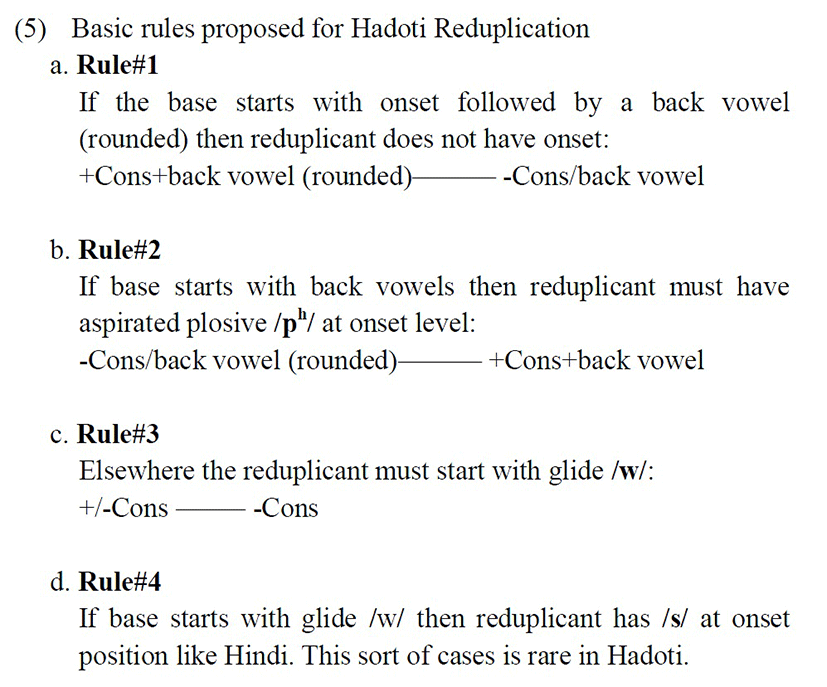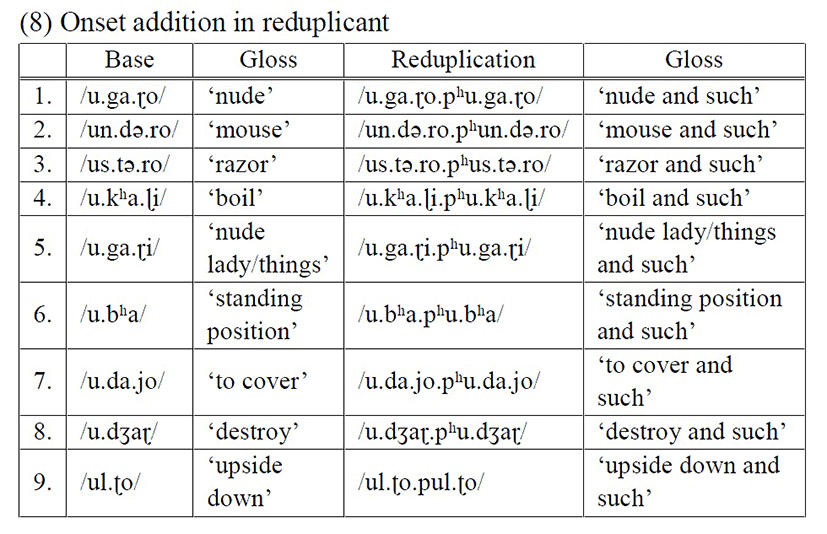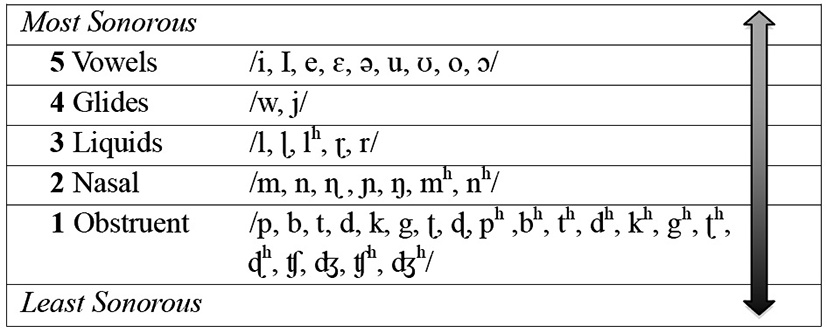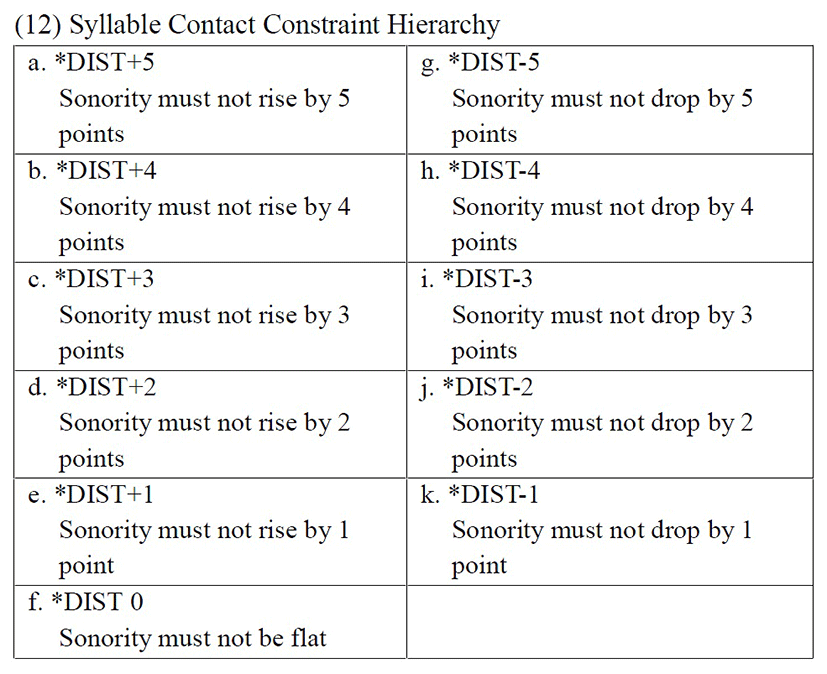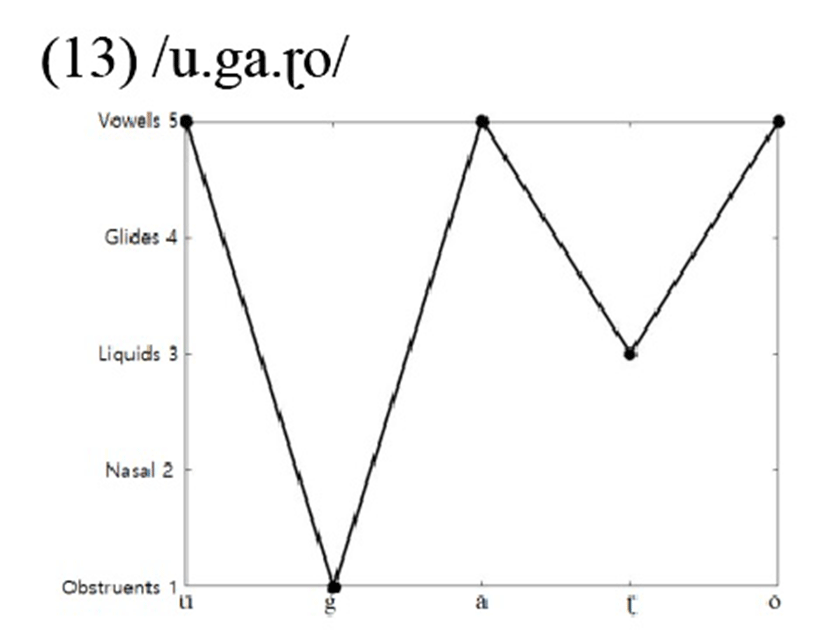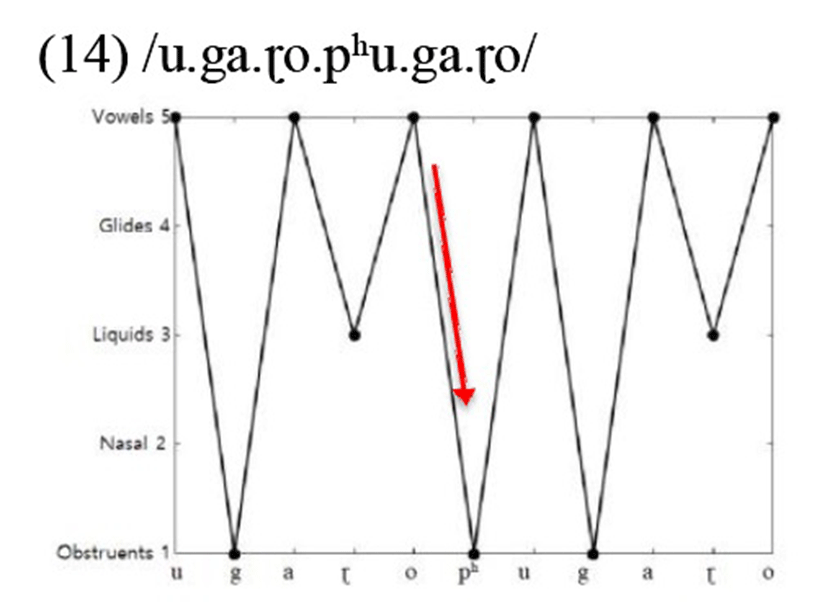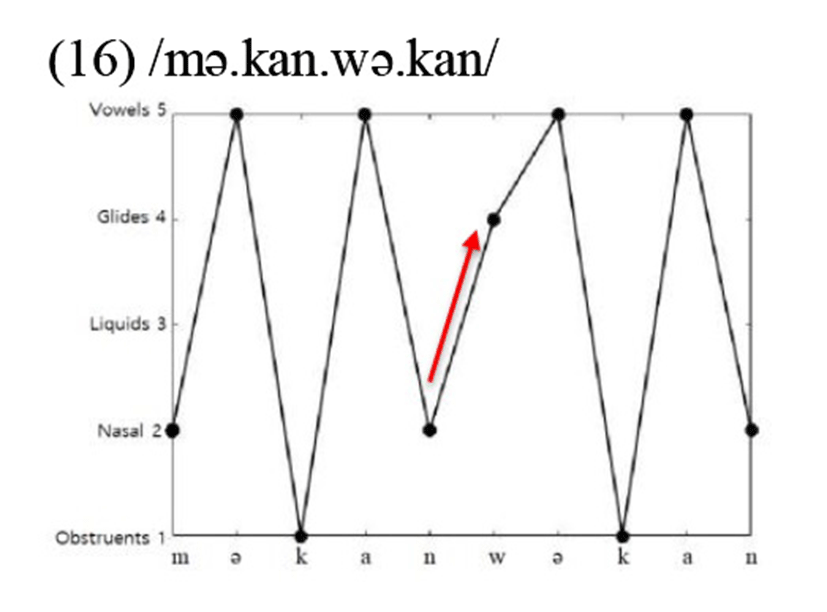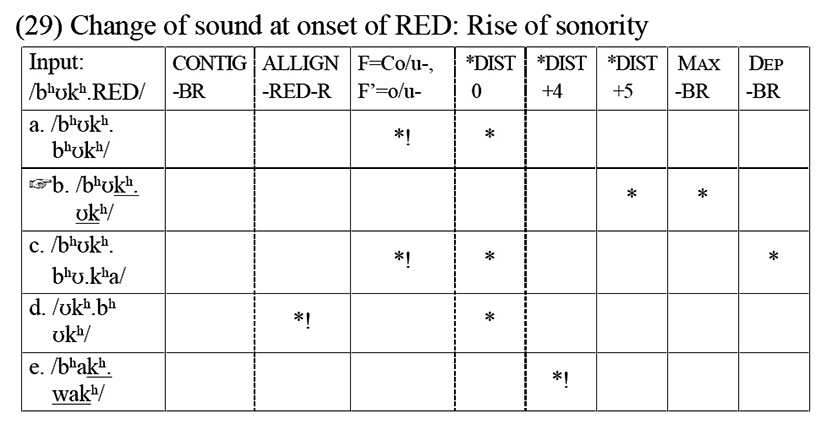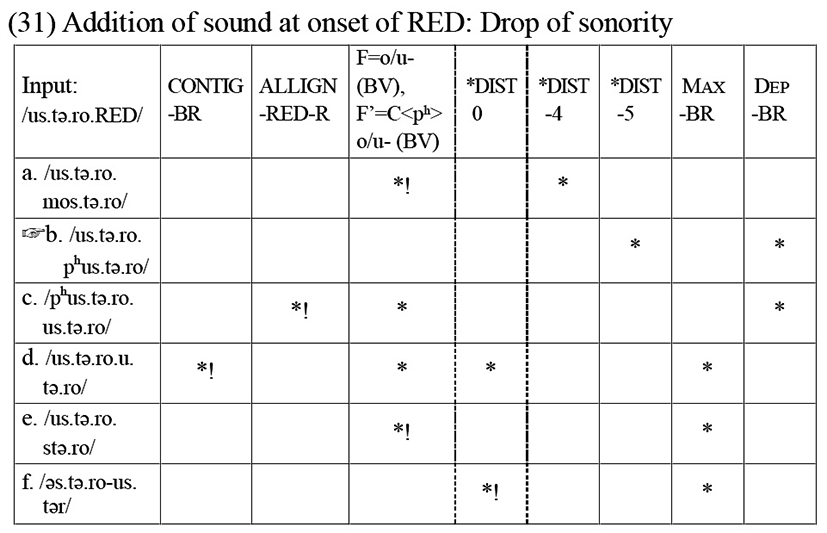1. Introduction
Reduplication is a common phenomenon among many South-Asian languages. Hadoti, being one of them, shows some interesting phonological features in connection to the sonority of segments in the reduplication process. While some of the earlier studies by Clements (1988), Gouskova (2001, 2002), Baertsch & Davis (2008), Kar (2010), and others have investigated the efficacy of the sonority scale in several areas, the present study attempts to describe operation of sonority in Hadoti reduplication process (henceforth, HR) using the grammatical framework of Optimality Theory (OT), propounded by Alan Prince & Paul Smolensky in 1993.
The concept of sonority as a prosodic feature is a fascinating aspect to study with respect to reduplication because sonority refers to the loudness of a speech sound relative to that of other speech sounds with the same length within a word but across the syllable boundaries. In other words, in the reduplication process, generally a syllable structure shows the nucleus as optionally surrounded by less sonorous segments that are available before the nucleus (onset) and after the nucleus (coda). If the final syllable of the base or stem is open, then reduplicant follows the sonority sequencing principle (SSP). In contrast, if the last syllable of the base or stem is closed, then reduplicant violates the SSP.
Hadoti is a regional variety spoken in and near Kota region of the Indian state of Rajasthan. It is also spoken in the neighboring regions of Madhya Pradesh. Hadoti displays productivity in its reduplication process. Interestingly, partial reduplication or an echo-word formation found in Hadoti as well as in another variety of Rajasthani, namely, Marwari, have not received much attention in morphological and phonological studies so far. It becomes a scholarly need to study Hadoti and its features and processes like reduplication linguistically, for a better understanding of the language and enrichment of the theory.
Reduplication in linguistics is a purely morphological process, where it is simply a kind of affixation through which it forms the morphological categories in languages. Within reduplication, the position of a reduplicant may vary from language to language, and reduplication may occur either in the form of prefixes or suffixes to the base or stem (left and right edge of the base). In Hadoti, the reduplicant gets attached as a suffix. The process pertains to a standard morphological feature of language wherein there is a repetition of stem/root of a word either completely or partially. However, in phonology, the process of reduplication is not considered as affixation but as a process in which segmental contents are completely repeated/copied or changed from the base and forms the reduplicant in the language.
Hadoti has three types reduplication process, namely, complete, partial (echo-words), and onomatopoeic (non-lexical). ‘Echo- formation fully refers the partial repetition of a phoneme or syllable of the base’ (Asad 2015: 39). Reduplication is used in Hadoti for several reasons, such as when it appears with a noun to express the number (singular and plural), the verb to mark the continuative and emphasizing process of the work and as an adjective to emphasize the quality of the things.
In the case of partial reduplication, many languages throughout the world have different ways for the reduplicant creation. While reduplicating, some of them show a very systematic and predictable pattern. For instance, in Sanskrit, /sa-swar/ ‘sound’ shows a regular pattern of perfective reduplication where the second consonant from the onset cluster of the base gets omitted in the reduplicant keeping the following vowel intact (Kager 1999: 214). In this study, we discuss the partial reduplication process (Onset change, Onset deletion, and Onset addition) from the Hadoti data. Based on the observations of reduplication process this study would like to address some basic questions.
To answer the first question, we focus on the onset deletion in reduplicant, which takes place when the base starts with [+cons] and followed by [+rounded] back vowels. Thereafter, in case of addition, when the base starts with a [+rounded] back vowel, the reduplicant must start with [+cons], which is an aspirated plosive /pʰ/ (in most instances, except few cases like /dʒʰuʈ-muʈ/ ‘lie’, /kuʈ-muʈ/ ‘beat’ etc.) In this condition this is also the unmarked feature of the given language.
Consequently, it is observed that Hadoti has a fixed segment for partial reduplication as pre-specified segment /w/ (common with Hindi). This segment /w/ occurs at the onset position of the reduplicant and shares the [+syllabic] item (shares the rounded feature of back vowels) with most other Indo-Aryan languages. Since reduplicant must start with /w/ a voiced labial approximant/semi-vowel and phonemically it shares the same feature as vowels [+sonorant] in the given language. As discussed above, two rounded segments cannot occur at the reduplicant initial syllable position. Now, for the first part of the second question, if the base starts with [+cons] segment then reduplicant must have /w/ at onset position, which is again a rounded vowel. The second part of this question enquires about the occurrence of the segment /w/ at the onset position of the reduplicant and the initial answer to this is because it acts as the unmarked feature at the onset position of reduplicant in Hadoti. Tak (2007: 113) argues that in comparison to the phonotactic constraints in a language, reduplicants have a tendency for more unmarked structures. Hence, it can be said that if the base starts with onset or front and central vowels than reduplicant must start with a [+syllabic] segment, which in this case is /w/. Sometimes in Hadoti Reduplication onset addition takes place when the base starts with front or central vowels, reduplicant will start with onset /w/, i.e., /am/ ‘mango’, /am wam/ ‘mango and such’. In this example, onset is added in reduplicant. In HR process, if the base starts with vowels, then sonority falls or goes down at the syllable boundaries, while in most of the cases, the base starts with onset, and eventually, the sonority rises at base reduplicant (BR) syllable boundary.
2. Background of the Study
The two major forms of reduplication in Hadoti are complete and partial reduplication. Hadoti is part of Indic dialect continuum wherein Hindi holds the standard variety position. HR, mostly shares the general pattern of Hindi reduplication process. This can be explicated through some discussion on Hindi reduplication literature as analyzed by Nevins (2005).
‘In Hindi, the “(noun) and the like” construction consists of total reduplication with the caveat that the second copy is modified so as, to begin with v (a). The v replaces an initial consonant, if any, in that stem. The dissimilatory motivation underlying v-replacement is revealed by what happens with stems that would begin with v anyway: in just these cases, an alternative initial consonant (sˇ) is provided.’
(Quoted from Inkelas 2008: 358)
Nevins further discusses the given examples (Quoted from ibid.):
Following Montaut (2009), in Hadoti, /w/ can be considered unmarked as a kind of alternation. When the base does not have an onset and starts with a front or a central vowel (as the peak), segment /w/ is added in the reduplicant as the new onset. This is called adjunction and not a substitution. Such a phenomenon is omnipresent in all the so-called “dialects” or regional varieties of Hindi, although it often displays a consonant different from the ‘v-’ used in Standard Hindi (Montaut 2009). Nevins and Montaut used transliteration for presenting data in their studies. In Hindi phonemic inventory, /w/ is used for ‘v’ sound, while in present study all the Hadoti data are transcribed with the help of IPA sound symbols. Montaut (2009: 39) formulated the set of following patterns for Hindi.
In (4), F stands for the base, whereas F’ for the reduplicant in a given language. In case of (4i), ‘C’ represents the initial syllable consonant in the base and ‘-’ is used for the rest (segments) in the given word. The second part of (4i) has F’=v-, where ‘v-’ stands for the first sound segment (the consonant /v/) of the reduplicant, followed by all other segments from the base.
In Hadoti, another type of partial reduplication occurs, in which F=o/u-, F’=C<pʰ>o/u- describes that if base starts with back vowels without consonant than reduplicant must have consonant segment /pʰ/ followed by all segments of the base. According to this rule, set F is a base form and set F’ a partial reduplicant.
To elaborate the formulae, ‘C’ stands for consonant and ‘-’ represents the rest of the segments, while ‘v’ (small v) stands for the fixed segment /w/ In (4ii), Co/u stands for any consonant followed by a back vowel and ‘V’ (upper-case V) stands for any vowel, while vV stands for /w+vowel/.
Above discussed phenomena can be understood through some basic rules formulated to describe the partial reduplication process.
From the above-stated rules, it can be said that, in the case of the partial reduplication process, two rounded segments cannot occur at the initial position of the word, i.e., /w/ and back vowels. This kind of construction only occurs only in the third person singular masculine pronoun /wu/ ‘he’. Syllable in any language is constructed of a combination of vowels and consonants. In many languages of the world, CV and CVC are considered as preferred syllable structure similarly in Hadoti the most preferred syllable structures are CV and CVC. Different languages allow different combinations of vowels and consonants. Content et al. (2001: 178) discuss that “Syllables constitute the natural domain of many phonological processes so that phonological regularities or alternations receive simpler and more economical descriptions when the syllable environment is specified”.
The formation of Hadoti syllables restricts very few consonants, which are not permissible at the word initial position. Dwivedi (2012: 17) suggest a list of such sounds that includes retroflex nasal /ɳ/, palatal nasal /ɲ/, velar nasal /ŋ/, and retroflex lateral fricative /ɭ/. Applying this in the case of reduplication process in Hadoti, this study focuses on the CV and CVC pattern in base and reduplicant. In Hadoti, reduplication can be formed of maximum quadri-syllabic words, like /gə.nə.kə.ɖo/ ‘dog’, /gə.nə.kə.ɖo.wə.nə.kə.ɖo/ ‘dog and such’.
In Hadoti, the segments and prosodic identity of the base and reduplicant are always identical through the complete reduplication process, where all the segments of the base are copied in the reduplicant (e.g., CV.CV.CV.CV). For instance, /kə.ʈʰi.kə.ʈʰi/ ‘where else’ (Base: /kə.ʈʰi/ ‘where’). Here, /kəʈʰi/ ‘where’ itself is a root word that provides the semantics of the construction and this is used for singular number or single place, while with reduplicant (/k1ə2.ʈʰ3i4.k1ə2.ʈʰ3i4/ ‘where else’), it specifically represents the semantic value ‘more than one place’ or shows the plurality of the places. Therefore, /kə.ʈʰi.kə.ʈʰi/ is a reduplicated form in Hadoti and not a quadri-syllabic root.
Here we illustrate instances of reduplication process in Hadoti.
The operations of onset deletion and onset change in Hadoti reduplicant often appear to target the base having consonants ending with low or rising sonority. The table in (8) represents instances of Hadoti reduplication where the onset epenthesis is evident in the reduplicant.
In Hadoti reduplication process, the base starts with any back vowel than reduplicant gets an onset segment /pʰ/. However, the examples in table (9) show another operation where the onset in the base is being deleted in the reduplicant.
When the base starts with onset followed by back vowels, reduplicant must not have onset at first syllable.
As discussed before, Hadoti reduplication process generally follows the Hindi reduplication pattern. In Hadoti, when the base starts with a consonant or front or central vowels, the first syllable of the reduplicant must have the onset /w/. This is the fixed segment in Hadoti to form partial reduplication.
Hadoti, too, depicts several ways of partial reduplication formation where one finds that maximum segments are copied from the base form (except the onset), as in /r1o2ʈ3i4.o2ʈ3i4/ ‘bread or something’. In this example, the base has four segments C1V2C3V4, while reduplicant starts from V2C3V4. In another example of the onset deletion scenario, namely, /bʰʊkʰ.ʊkʰ/, the syllabification cannot be /bʰʊ.kʰʊkʰ/ because /bʰʊ/ is meaningless in Hadoti; hence, it does not qualify to be a base. The point made here is that the base onset C1 is deleted in the reduplicant. Hence, it can be said that if the base has a back vowel followed by the onset (a consonant) in the first syllable, then in the reduplicant, the onset will be deleted. This type of reduplication is different from other deletion-based phonological operations as seen in loanword phonology, where deletion is used as a powerful tool to nativize onset or coda clusters (see Nguyen & Dutta 2017: 78). In another instance of partial reduplication in Hadoti, if the base starts with a back vowel then reduplicant must have initial syllable onset, i.e., V.CV.CV.CV.CV.CV /u.ga.ɽo.pʰu.ga.ɽo/ ‘nude and such’. There might be other possible segments at reduplicant position of such cases, but in this research, we are considering only /pʰ/ at reduplicant position. In rest of the cases of partial reduplication seen in Hadoti shows that if base first/initial syllable has front and central vowel preceded by onset or without onset, the onset segment will be changed or added and the glide /w/ would be the onset of the reduplicant’s first syllable, which is shown in the data list.
Pertinently, the study attempts to claim that distribution of phonemes in any Hadoti reduplicated word (reduplicant) depends on its syllable structure and the prosodic feature of sonority.
The phonotactic rules of Hadoti are less complex as compared to some other Indo-Aryan languages. For instance, the retroflex nasal /ɳ/, palatal nasal /ɲ/, velar nasal /ŋ/, and retroflex lateral fricative /ɭ/ do not occur word initially. The rest of the consonants available in the phonemic inventory of Hadoti can occur at all positions. Out of the four nasal consonants, /ɳ/, /ɲ/, /ŋ/, and /n/, the velar /ŋ/ occurs when followed by /k/, /kʰ/, /ɡ/, and /ɡh/. On the other hand, the palatal /ɲ/ occurs when followed by /ʧ/, /ʤ/, /ʧʰ/, and /ʤʰ/. On the other hand, /n/ and /ɳ/ occur with any other consonant. However, when /ɳ/ comes in the medial position, it is always followed by a retroflex consonant (Dwivedi 2012: 17).
Most preferred syllable pattern in HR process is CV.CV. This statement can be established through the examples discussed, e.g., /u.ga.do.pʰu.ga.do/ (V.CV.CV.CV.CV.CV) ‘nude and such’ and /us.tə.ro.pʰus.tə.ro/ (VC.CV.CV.CVC.CV.CV) ‘razor and such’. The studied examples do not allow any complex onset (i.e., consonant cluster at the onset position). In case of Hadoti, it allows a complex onset for certain types of words wherein the complex onset is made by glides as the second consonant, i.e., /kjari/ ‘a rectangular place in garden to grow plants’, /kwaro/ ‘bachelor’, /gwadi/ ‘house’ etc. (Dwivedi 2012). The following syllable structure may be useful in understating Hadoti syllabification rules.
It is clear from the following diagram that (11a) is light in nature (monomoraic) and (11b) is heavy in nature (bimoraic). We can say from this in case onset does not have any mora the nucleus/ rhyming branch always has mora like many other Indian languages. In addition, coda also gets mora in Hadoti.
Noteworthy for the discussion is that many linguists have investigated the existence of cross-linguistic preferences for certain types of syllable structure and syllable contact. One such study is by Greenberg (1978) that described a number of generalizations suggesting that certain syllable types are less complex or less marked than others across languages.
3. Sonority and Sonority Sequencing Principle
The concept of sonority has been conferred widely with little agreement on the question of what sonority is and how it should be defined. Several scholars have proposed different phonetic parameters to characterize sonority. Selkirk (1984) defines it in terms of degree of opening and vowels are the most open, i.e., these are most sonorous sounds followed in decreasing order by liquids, nasals, fricatives, and stops. Ladefoged (1993: 227) defines sonority as the perceptual saliency or loudness of a particular sound. Nevertheless, the first comprehensive attempts to explain such a ranking to display the pattern of syllable structure are due to scholars like Sievers (1881), Jesperson (1904), Saussure (1916), and Grammont (1933). In current scenario, Jesperson’s version is the most familiar, where he states:
In jeder Laut gruppe gibte seben sovie le Silbenalses deut liche relative Höhepunkte in der Schallfülle gibt.
(‘In every group of sounds there are just as many syllables as there are clear relative peaks of sonority.’)
(Jesperson 1904: 188, quoted from Clements 1988: 3)
Based on earlier research in this domain, Clements (1988: 3) formalized provisional version of the Sonority Sequencing Principle (SSP): Between any member x of a syllable and the syllable peak p, only sounds of higher sonority rank than x are permitted.
In other words, the sonority of a syllable structure starts from low onset consonant, followed by a vowel as you reach the peak, and then fall towards the end of the syllable coda another consonant, which is lower than the vowel (peak) in the same syllable. To express SSP in Hadoti a scale is proposed in (12).
As mentioned in the introduction, Sonority scale and its significance have long been important in the discussion of syllable structure, several scholars pointed out that syllable structures have a preferred sonority pattern (see Zec 1995 for recent work). According to this hierarchy, a syllable can be considered to be unmarked. One certification of this unmarked syllable structure is that there is a complete as well as a sharp rise in sonority between the onset and the nucleus; thus a typically non-sonorant onset and an extreme sonorous nucleus are preferred and fall towards the coda (less sonorant to peak).
In Hadoti, syllable formation is based on the sonority of the given segments. This follows from the rule of other languages wherein the most sonorous segments occupy the nucleus position. Similarly, in Hadoti vowels and sonorous segments get the peak position and help to form an unmarked syllable. This study is an attempt to describe the kind of syllable structure is unmarked in Hadoti reduplication process. Sonority rising at syllable boundary is a marked feature in all languages. To note HR sonority rising is an unmarked feature as in the examples, /bʰʊkʰ.ʊkʰ/ and /kə.tjab.wə.tjab/. With these and other illustrations from the language, it can be generalized that in the base words (or stems), the syllables are arranged according to the sonority of the segments, but as the base is used with a reduplicant, the sonority becomes irrelevant in HR. Thus, our aim here is to examine the status of sonority of reduplication process within a phonological framework.
What follows in this section is this inquiry that is specifically concerned with sonority restrictions on onset segments during reduplication process. In this paper, we use the Syllable Contact Constraint Hierarchy. This hierarchy is adapted from Gouskova’s work.
Syllable Contact is proposed to be a universal constraint hierarchy entailing that the markedness of a coda-onset sequence increases with sonority rise and decreases with sonority drop. (Gouskova 2003: 1)
The adapted hierarchy has been modified from a 7-distance hierarchy to a 5-distance hierarchy, because in this study, we are considering a 5-point sonority scale. Kar (2010) successfully followed the same scale for Bengali (another Ind-Aryan language, spoken in India and Bangladesh). These constraints evaluate individual positions and are the product of Harmonic Alignment (Prince & Smolensky 1993). In a language, most marked constructions are not admitted unless the less marked are not accepted. The ‘Syllable Contact Constraint Hierarchy’ deals with the distance between the coda and the onset sequences for rising and dropping of the sonority. The ‘Syllable Contact Constraint Hierarchy’ is described below:
During the reduplication process, both margins of a syllable may present any number of consonantal segments and such segments should be dependent on sonority scale, i.e., they should follow the Sonority Sequencing Principle (SSP). SSP, as discussed, is a principle, which claims that in a syllable, sonority should increase towards the peak and decrease towards the margins. Thus, the nucleus contains the most sonorous segment, while the less sonorous ones occur towards the margins.
Furthermore, this sonority sequencing arrangement is not merely applied at the syllable-initial or the final position. During the reduplication process in Hadoti, the segments of the reduplicant are arranged according to the SSP. The other point to note about reduplication in Hadoti is that it displays fixed segment with /w/ at the onset of the reduplicant. The significant aspect to consider here is that onset segments are the consonants occurring at the beginning of the syllable (e.g., /t/ in ‘tap’). Although languages allow onset segments, not all segments are equally preferred: an onset such as /w/ is more frequent in Hindi as compared to onset such as /t/, which in turn are more frequent as onsets in Bangla.
Likewise, reduplication process is based on the sonority pattern in Hadoti, i.e., /tə.lab.wə.lab/ ‘a pond’, where /w/ is a glide; replaces the obstruent /t/ at the onset position during partial reduplication process. Since glides are more sonorous than obstruent when reduplication occur, the sonority of the reduplicant onset is at a different (high) level compared to the coda of the base of last syllable, therefore after reduplication, the reduplicant has the higher sonorous segment at first syllable. Hence, in this instance, sonority rises as well as shifts during reduplication process.
Another important point note here is when a base word begins with higher sonority segments (back vowels), (e.g., /u/) display reduplication with non-identical segments such as /us.tə.ro.pʰus.tə.ro/ ‘razor and something’. This is an instance of prothesis wherein the segment /pʰ/ is added to the reduplicant onset position during reduplication process. When reduplicated as /us.tə.ro.pʰus.tə.ro/, the reduplicant has /o/ as more sonorous segment compared to the following segment in the onset of the reduplicant (/pʰ/). Nonetheless, there is a change after the reduplication; the reduplicant has the least sonorous segment at the first syllable. As a result, we can say that in above example, i.e., /tə.lab.wə.lab/ rises in sonority and in another /us.tə.ro.pʰus.tə.ro/ falls or drops in sonority. In the reduplicated form the coda of the previous syllable ends with less sonority than the sonority of the onset of the following syllable. Therefore, one can resolve that the syllables can be analyzed in isolation or as reduplicated set, but in both cases they occur in accordance with the sonority sequencing principle.
In the below graphs (13) and (14), the sonority level of the given data is represented with the help of line graph. This graph has been prepared on the basis of (Figure 1) Sonority Scale (Hadoti). The graph (13) reprsents the base form /u.ga.ɽo/ and (14) represents the graph for the reduplicated form of /u.ga.ɽo/, i.e., /u.ga.ɽo.pʰu.ga.ɽo/ in Hadoti. This exemplifies the loudness of the speech sound in the language. In the given graph one can see that the lines that are touching point 5 can be said to be the vowels and those lines that are between points 0 to 1 or the ones that are at the level of point 1 are the obstruents. The graphs only discuss certain types fixed segment and onset addition reduplication process of words in Hadoti.
As seen in the above discussion, Hadoti has two other instances, /u.ga.ɽo.pʰu.ga.ɽo/ ‘nude and such’ and /un.də.ro.pʰun.də.ro/ ‘mouse and such’, where the deviation of the reduplicant from the base is truly controlled by sonority. There are some other examples which follow almost similar pattern. The above-mentioned reduplication in Hadoti shows that the reduplicant is a copy of the base in every aspect except for the initial segment /pʰ/, which was introduced through epenthesis, which makes such structures perfectly unmarked. For the most marked construction, the sonority raises to the maximum level whereas the falling sonority idicates the most unmarked construction universally.
While in another set of graphs in below (15) and (16), we see that in the base form, the syllables are following SSP. In general, for such instances in the process of reduplication, it is observed that the syllable boundaries of the base and the reduplicant do not follow the SSP. Boundaries between the base and the reduplicant are shown using the dot (.) which is used for syllable boundary as well. It is because of the onset of reduplicant is the fixed segment /w/ (semi-vowel) in the partial reduplication process in Hadoti. Since the fixed segment /w/ at the onset/initial position of the reduplicant is less sonorous than vowels and more sonorous than all other segments in Hadoti. The sonority rising can be seen in (16) through the arrow line. Hence it can be said that in partial reduplication process in Hadoti if base ends with vowels, then reduplicant follows the SSP else it violates the SSP.
Based on these observations, a sketch of syllable structure of reduplication is prepared and then we discuss the role of sonority scale and the hierarchy of Syllable Contact constraints during reduplication process in this variety.
4. Theoretical Framework and Method of Application
OT describes the selection process of the optimal candidate in any given language by judging the fatal violations of candidate outputs as generated by GEN from each input. The candidate best satisfying the set of universal constraints of the language is considered as the optimal candidate or output. Alan Prince and Paul Smolensky proposed Optimality Theory (OT) in early 1990’s which was developed as a new and powerful theory of human language afterwards. OT believes to be one of the top three developments in the history of Generative Grammar (McCarthy & Prince 1993a, b). Moreover, this theory is considered as an apt tool for explaining typological features in various languages, thus the present study attempts to further establish its efficacy in Hadoti.
The major notion related to Hadoti as mentioned earlier is the phonological components of the reduplication process. OT contributed significantly in case of reduplication by developing the Correspondence Theory (as the theory within a theory model). This framework studies correspondence relationship between input and output segments/elements, which are attributed to ‘faithfulness’. Kager (1999: 205) says, “In fact, this notion of correspondence is all we need to capture the identity relation between the base and the reduplicant, if only we generalize it a bit”. Here, we will look into the base and reduplicant correspondence as given by McCarthy & Prince (1995: 262).
Max-BR is a faithfulness constraint, which does not allow any kind of deletion of input and output. It prohibits any kind of deletion in the base (B) and the reduplicant (R), which means, it requires the same number of segments in input and output.
This constraint is violated when input lacks a correspondence to output segment. Such a violation happens by insertion of /pʰ/ in reduplicant output. That is, /u.ga.ɽo/ ‘nude’ is the base form as input but /u.ga.ɽo.pʰu.ga.ɽo/ ‘nude and such’ in output /pʰ/ inserted as an onset of the reduplicant.
In tableau (23), we find that F=o/u-, F’=C<pʰ>o/u- dominates Dep-IO and it dominates MAX-BR. Onset constraint requires that syllables must have onset. Candidate (23a) is considered the optimal candidate in above tableau, because it consists the least expensive violation. The optimal candidate (23a) does not violate the highest ranked constraint because the base does not have any onset. Candidates (23b) and (23c) have fatal violations at the highest ranked constraint. Prince & Smolensky (1993) argue that in language enforcing syllable onset by consonant epenthesis, onset takes precedence over the faithful constraint ‘FILL’, requiring that ‘syllable positions must be filled underlying segment’.
In the above tableau, deletion happens at the onset position of the reduplicant, i.e., /kʰʊ.dʒar/ ‘itching’ (base) to /kʰʊ.dʒar.ʊ.dʒar/ ‘itching and such’ (reduplicated form) as seen in the candidate (24a). This candidate emerges as the optimal candidate because the highest ranked constraint demands that the onset must not be present in first syllable of the reduplicant. Here, the base starts with a dorsal sound (/kʰ/), followed by a back vowel (/ʊ/), while the reduplicant does not have any onset. This leads to only one violation at the lowest ranked constraint (Max-BR), which is least expensive in this tableau. In case of (24b) and (24c), both the base and the reduplicant have the onset with dorsal coronal feature and higher ranked constraint F=Co/u-, F’=o/u-demands that onset must not be at reduplicant initial syllable. Here the F=Co/u-, F’=o/u- >> Dep-BR. Therefore optimal candidate (a) has less marked structure. The following section will take help from the above observations and analyze the said data.
5. Analysis
Earlier, in the introduction, it was mentioned that the present work would focus on the phonological aspect of Hadoti reduplication. This variety, like in many other languages, does not have syllables in accordance with the surface form CVC. As a result, applying OT to Hadoti data, this study investigates constraint interactions to optimize the unmarked syllables in the language.
In this study, the following constraints are used for analysis, as most of them are proposed and used by several other scholars. On the basis of constraint ranking, the following scheme is prepared.
F=V/C-, F’=w- is markedness constraint Which requires if the base has any segment as initial syllable onset followed by front and central vowel than reduplicant must have /w/ segment as onset and rest following segments remain same in the reduplicant construction.
In the above-given tableaux (29) and (30), it can be seen that candidate (a) is the optimal candidate in both tableaux because both candidates (29a) and (30a) pass the higher ranked constraints CONTIG-BR, ALLIGN-RED-R. As CONTIG-BR requires nothing should be skipping or intrusion at a medial position in base and reduplicant. Candidate (30e) is violating the faithfulness constraint CONTIG-BR in which /ə/ added in the medial syllable and in 30 candidates pass through this higher ranked constraint. These all candidates have the violation at the third highest ranked constraint, namely, F=V/C-, F’=w-, which takes them out from the competition in the tableau. Further, higher ranked constraint ALLIGN-RED-R requires that reduplicant alignment should be at the right edge of the base because this is one of the correspondence constraints. Hence, candidates (29b) and (29e) get punished and violated by ALLIGN-RED-R, a second higher ranked constraint in the tableaux. In the foregoing tableaux (29) and (30) faithful and correspondence constraints (under faithfulness constraints) dominate the reduplicative identity constraints, i.e., MAX-BR, that requires that there should not be any segment deletion in base and reduplicant. This constraint has been violated by (29d), (29e), and (30b). In both cases the hierarchy of faithfulness constraints is CONTIG-BR, ALLIGN-RED-R >> Max-BR. To check the marked structure in the given language, markedness constraints occur between correspondence constraints and reduplicative identity constraints. This sandwich condition is called emergence of the unmarked (TETU). In the presented tableaux, the markedness constraint is F=V/C-, F’=w-, which requires that if the base has any segment as the onset of the initial syllable followed by front or central vowels, then reduplicant must have /w/ segment as the onset and the rest of the following segments remain same in the construction of the reduplicant. Hence, the candidates (29b-e) and the candidates (30b-e) get violated, and (29a) and (30a), respectively, pass without any obstruction at the higher ranked constraints. The other constraints in the presented analysis are the SYLLCON hierarchy constraints, i.e., *DISTs ‘+’ , ‘0’, and ‘-’, which talk about the distance between coda and onset, and a markedness constraint, which require that no sonority rises, flat and drop across the syllable boundary, based on the distance. Such constraints are the decisive constraints to prove that which construction is unmarked or marked according to the condition. To continue the analysis, (29a) and (30a) violate *DIST+2 and *DIST-1 constraints because the sonority rises across syllable boundary in the output form which is a marked feature in many languages of the world. As mentioned before, the highest sonority rising in distance is most marked construction in any language, less distance in sonority rising is less marked construction. Nevertheless, this phenomenon is not only present in Hadoti, but also seen in other Indo-Aryan languages, such as Hindi and Bhojpuri. Therefore, it can be said that this is a less marked feature of the given language in case of partial reduplication process. Thus, candidate (a) in both (29) and (30) becomes the optimal candidate, because it has the least expensive violation in a set of ranked constraints.
In present tableau (31) the faithful and correspondence constraints CONTIG-BR, ALLIGN-RED-R are higher ranked constraints, which dominate all the markedness constraints and faithfulness constraints (base reduplicative identity). (31d) is ruled out from the competition because CONTIG-BR is a higher ranked constraint. The candidate (31c) violated the second higher ranked constraint ALLIGN-RED-R, as it requires that reduplicant must be attached to the right edge of the base and in (c) reduplicant is attached to the left edge of the base. In case of the candidates (a, e) they are eliminated by the third higher ranked constraint F=o/u-(BV), F’=C<pʰ>o/u-(BV), because F=o/u-, F’=C<pʰ">o/u- ask for epenthesis at onset level only when base starts with the back vowels. This constraint defines that onset must be only /pʰ/ in the reduplication process and this makes the discussed construction as unmarked in studied language. The candidate (31b) gets two violation at the lower ranked constraint *DIST-5 and MAX-BR, which demands that no drop of sonority at the level 5 and no partial reduplication. As a result, (31b) becomes the optimal output, because it gets the least expensive violation in the given hierarchy.
The above-presented tableau (32) provides an illustration of an opposite reduplication process from the previously analyzed tableau (31). Here the hierarchy is same as in the previously presented tableaux. In this instance of reduplication process (32) onset deletion happens at the reduplicant initial position, which we have discussed in the introduction section. The markedness constraints F=Co/u-, F’=o/u- is used because it says that if the base begins with onset followed by only back/ rounded vowels then partial reduplicant must not have an onset at initial syllable. The candidate (32d) is violated at the higher ranked (faithful) correspondence constraints, i.e., ALLIGN-RED-R. Next ranked markedness constraint F=Co/u-, F’=o/u- will be violated by the candidate (32a & c) because both do not fulfill the above-mentioned requirement. The optimal candidate (b) gets punished at *DIST+5 and MAX-BR constraints because *DIST+5 requires that no sonority rising across the syllable boundary at the level of 5. In case of (b), the base syllable has coda /kʰ/ and it is an obstruent, which has -sonorant feature and its reduplicant starts with the most sonorant segment /ʊ/, which coda and vowel have 5 point distance which is universally most marked feature. In Hadoti this construction is less marked or unmarked construction in this phenomenon. This sonority hierarchy constraints play the decisive role to get optimal candidate between (b & e) in above analysis candidate (e) get punished at *DIST+4 while candidate (b) is violated *DIST+5, which is lower ranked. As a result to conclude the analysis the discussed types of constructions are marked in many languages but in Hadoti it is less marked construction in day-to-day spoken form.
6. Discussion
The study presentated in this paper established that sonority in Hadoti reduplication could be illustrated within the framework of Optimality Theory with the help of a set of Markedness constraints. Further, these constraints are ranked between correspondence and reduplicative identity constraints in the hierarchy. Therefore, violating the sonority phenomenon, as seen in HR, the unmarked structure comes into existence. In (25), we presented a schema wherein ranking of the constraints explained that the Markedness constraints emerge between the Correspondence Faithfulness constraints and Reduplicative Identity. The schema of the constraint hierarchy can then be said as following this hierarchy: Faithfulness constraints (correspondence) >> Markedness constraints >> Reduplicative Identity. Syllable Contact constraints, i.e., *Dist (-5 to +5), F=Co/u-, F’=o/u- constraints are markedness constraints while Contig-BR, Align-Red-R, and Max-BR are the correspondence (faithfulness) constraints whereas Max-BR, Dep-BR, and Contig-BR are the constraints under the Reduplicative Identity.
In the given variety, the otherwise marked sonority constructions are accepted as unmarked constructions. This is due to the universally marked sonority rising across the syllable boundaries. This was found to be an exception in the studied language, wherein the analysis showed that the unmarked can only occur during a specific situation. Establishing this analysis the authors consider Gouskova’s study where she states:
“However, no predictions are made about the patterning of sequences with the same sonority distance. This is because sequences with the same sonority distance are represented by 2 separate constraints, which can be ranked differently in individual languages.” (Gouskova 2002: 253)
Following this, the highest sonority rise (as in /kʰaʈ.waʈ/ and /bʰʊkʰ.ʊkʰ/) can be said as most marked universally. On the other hand flat sonority (roʈi.oʈi) can be said as less marked, and the highest sonority drop is least marked (as in /u.ga.ɽo.pʰu.ga.ɽo/).
The highest sonority rise (in distance) in the earlier discussed example is DIST+5 points, which is the most marked construction universally. This rule is generally followed in most cases of Hadoti partial reduplication if the base has other vowels except back vowels. However, it was seen during the analysis that in Hadoti when base had back vowels, this became an unmarked construction as shown in the example /bʰʊkʰ.ʊkʰ/. Furthermore, in Hadoti if the base has back vowels in the first syllable, then the reduplicant must not have onset at the level of the first syllable. Hence, Hadoti partial reduplication process generally gets rid of sequences with flat sonority.
Applying the above hierarchy to the analysis of HR data we found that when the base starts with a peak (nucleus) or only back vowel then reduplicant gets an aspirated obstruent at onset position at the level of the first syllable. The other case showed that when base form starts from consonants and nasal consonants followed by a back vowel then reduplicant does not contain onset at first syllable. Onset is deleted in reduplicant’s first syllable. As hypothesized in the introduction of the study in above analysis it was revealed that sonority is not a marked feature in Hadoti. Moreover, with the help of present data, it was further highlighted that sonority starts from the peak and decreases towards less sonorous level. This happens in case of the first syllable of the word. In other cases, sonority starts from level 1 to level 5 and falls at the level 1. The above data showed that in Hadoti, generally, the case is that at some point there must be a syllable, which starts from the peak (Back Vowels) point and decreases towards the syllable margin. Thus the analyzed data within the Optimality Theoretic framework postulated the exploration wherein Syllable Contact constraints and few other constraints were applied and these provided the base for understanding the significant role-played by sonority in HR process.
7. Conclusion
To summarize, the present study examined the role played by sonority in the reduplication process available in Hadoti, by enumerating the data within the theoretical framework of Optimality Theory. According to the analysis conducted through constraint hierarchy presented with the help of tableaux (29), (30), (31), and (32) it was concluded that OT can be considered as an apt tool in describing the phenomenon of sonority in reference to reduplication process in Hadoti. As mentioned in the study sonority in phonology is referred to the strength or loudness of a speech sound relative to that of other speech sounds with the same length. Moreover in the study arrangement in the reduplication process was based on the syllable of the base form, which in turn followed the SSP. It was further argued that SSP in HR process restricts the marked construction of speech sounds. Syllable structure of reduplication in Hadoti was prepared with a peak optionally surrounded either by less sonorous segments before the nucleus (the onset) or after the nucleus (the coda).
The study demonstrated with the help of data analysis that the hierarchy of the ranked constraints for the examples played a crucial role in justification as well as gets the optimal candidate in the said language. In particular analysis section (29) and (30) tableaux showed how the Markedness constraints, i.e., Syllable Contact (SyllCon) constraints played an important role to get an optimal candidate with respect to SSP. The said constraint punished all the candidates, which did not fulfill the requirement of the ranked constraint. Further, to substantiate our point this ranking maintained the sonority in given language according to SSP.
Additionally, the tableaux (31) and (32) showed similarly, the Faithfulness constraints are high ranked and dominate the Markedness constraints. In that given case Syllable Contact was a lower ranked constraint in markedness hierarchy.
Since Syllable Contact constraints, i.e., *DISTs required no sonority rising over the syllable boundary however in (31) and (32), some candidates, those which were somehow similar to optimal candidates were violated at the higher ranked constraint. Candidate (31b & 32b) passed the higher ranked constraint (to fulfill the requirement) and became the optimal candidate. The analysis displays the emergence of the unmarked (TETU) in HR process. Therefore, the study concludes that constraints in Optimality Theory were able to describe the relation existing between reduplication process and sonority in Hadoti.











